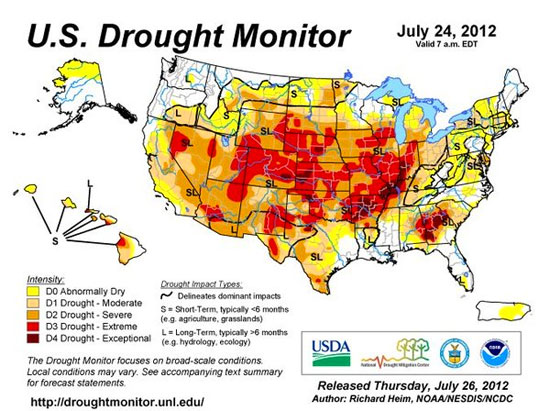Maybe you didn't make the connection between the US drought, the extreme summer heat and our food supply.
Below is a collage of articles, explaining the peril we face.
Our single greatest threat is GLOBAL WARMING. [Click on links for additional information.]
From: Andy Soos ENN
Published December 3, 2012 08:45 AM
Shale Oil and How It Changes the World
Oil shale, also known as kerogen shale, is an organic-rich fine-grained sedimentary rock containing kerogen (a solid mixture of organic chemical compounds) from which liquid hydrocarbons called shale oil can be produced. Shale oil is a substitute for conventional crude oil and the USA has a lot of it. The global energy map is changing, with potentially far-reaching consequences for energy markets and trade. It is being redrawn by the resurgence in oil and gas production in the United States due to shale and could be further reshaped by a retreat from nuclear power in some countries, continued rapid growth in the use of wind and solar technologies and by the global spread of unconventional gas production.http://www.enn.com/top_stories/article/45289
From: Emily Sohn, Discovery News
Published December 3, 2012 08:29 AM
CO2 Output Hits Record High
Around the world, we are emitting more carbon dioxide than ever.For 2012, according to new projections by the Global Carbon Project, there is likely to be a 2.6 percent rise in global CO2 emissions from the burning of fossil fuels compared to the year before. That puts emissions of the gas at 58 percent higher than 1990 levels.
In 2011, China was the biggest producer of CO2, accounting for 28 percent of global emissions, researchers report in the journals Nature Climate Change and Earth System Science Data Discussions. The United States followed with 16 percent, the European Union with 11 percent and India with seven percent.
Regionally, emissions are increasing faster in some places than in others. In 2011, emissions grew in China by nearly 10 percent and in India by more than seven percent.
In the United States and the European Union, on the other hand, emission rates declined by a couple of percentage points.
Still, in emissions-per-person tallies, the United States led the way with more than 17 tons of CO2 released for every American. The European Union came next with just over seven tons per person. China was close behind and India was lowest, with slightly less than two tons emitted per person.
Article continues at Discovery News
http://www.enn.com/top_stories/article/45291
From: TIM FAULKNER/ecoRI News staff
Published December 3, 2012
Planning for Climate Change
The Metcalf Institute at the University of Rhode Island recently held the second in series of seminars on climate change. The program honors the late Peter B. Lord, longtime environmental writer for the Providence Journal. Here are a few noteworthy points that were offered Nov. 30 by 15 scientists, engineers, planners and other experts:Snowpack in the Northeast has decreased its annual volume by 11 percent since 1900.
Sea level is projected to rise between 2.5 and 6 feet by 2100. "If you want to see what 5 feet of sea level rise will look like, you look at Hurricane Sandy," said Bryan Oakley, a URI researcher and professor of earth sciences at Eastern Connecticut State University.
Rebuilding on the coast after storms is ultimately futile, according to Oakley, an expert on shoreline erosion. “Retreat is the only sure option. The others are just Band-Aids.”�
Oakley recognized the reluctance of owners to give up their land. One possible option for keeping shorelines assessable, he said, is to build impervious road surfaces that adjust to the forces of erosion.
Coastal cities, Oakley said, face bigger challenges than beach communities, as elevating metropolises would be a massive and costly undertaking.
The National Park Service is adapting to climate change by replacing structures at its coastal parks with movable buildings. Asphalt parking lots are being replaced with permeable, clay-based materials and clamshells.
Salt marshes are considered ideal for coastline protection, especially during storms. It’s been asserted that marshes accrete, or essentially grow taller, as the sea level rises. But Wenley Ferguson, Save The Bay's restoration coordinator, said marshes may not be to keep up with rising sea levels, especially as erosion accelerates along their edges.
Flood zones, as determined by FEMA, don't take into account expected sea level rise.
http://www.enn.com/top_stories/article/45290
Permafrost
Thawing to Cause Additional Global Warming
Dangerous feedback loop as
existing warming accelerates permafrost thawing
November 27, 2012
By: Institute for Governance & Sustainable DevelopmentWashington, DC –Should permafrost
thawing accelerate as expected, resulting carbon dioxide and methane emissions
will significantly amplify global warming, according to a report published today
by the United Nations Environment Programme (UNEP) titled Policy
Implications of Warming Permafrost. Permafrost is ground that
stays frozen for at least two years in a row and occurs in about a quarter of
the land surface in the Northern Hemisphere; it contains twice the amount of
carbon as the atmosphere (1,700 billion tonnes of carbon stored as frozen
organic matter).Full Article |
Alarming Growth of Climate Emissions Says UNEP, But No Reason to Write Off 2°C Target Yet
November 21, 2012 By: Institute for Governance & Sustainable DevelopmentWashington, DC – Global greenhouse gas
emissions are moving in the wrong direction to meet the global goal of
stabilizing temperatures at or below 2°C by the end of the century, according to
the third edition of UNEP’s Emissions Gap Report developed by 55
scientists from 22 countries. According to the report released today, if all
countries stick to the voluntary pledges they have already made, by 2020
greenhouse gas emissions will be at least 8 billion tons higher per year than
the maximum allowed to meet the 2°C target.Full Article |


No comments:
Post a Comment